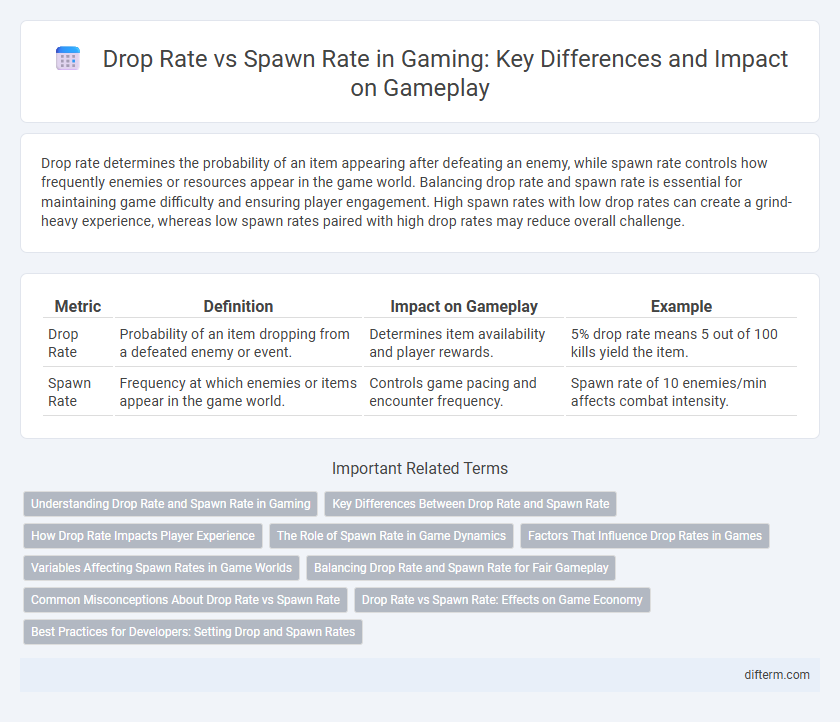Drop rate determines the probability of an item appearing after defeating an enemy, while spawn rate controls how frequently enemies or resources appear in the game world. Balancing drop rate and spawn rate is essential for maintaining game difficulty and ensuring player engagement. High spawn rates with low drop rates can create a grind-heavy experience, whereas low spawn rates paired with high drop rates may reduce overall challenge.
Table of Comparison
| Metric | Definition | Impact on Gameplay | Example |
|---|---|---|---|
| Drop Rate | Probability of an item dropping from a defeated enemy or event. | Determines item availability and player rewards. | 5% drop rate means 5 out of 100 kills yield the item. |
| Spawn Rate | Frequency at which enemies or items appear in the game world. | Controls game pacing and encounter frequency. | Spawn rate of 10 enemies/min affects combat intensity. |
Understanding Drop Rate and Spawn Rate in Gaming
Drop rate in gaming refers to the probability that a defeated enemy or completed event yields a specific item, while spawn rate indicates how frequently enemies or objects appear within the game environment. Understanding the distinction between drop rate and spawn rate is crucial for optimizing farming strategies and maximizing resource acquisition. Accurate knowledge of both rates allows players to plan effectively, balancing encounter frequency with item rarity to enhance gameplay efficiency.
Key Differences Between Drop Rate and Spawn Rate
Drop rate refers to the probability that an item will be obtained from a defeated enemy or completed event, while spawn rate indicates how frequently enemies or events appear in the game environment. Drop rate is typically expressed as a percentage chance per kill or event, directly impacting player rewards, whereas spawn rate controls game pacing and difficulty by determining enemy density over time. Understanding these distinctions helps players optimize farming strategies and manage in-game resource acquisition more effectively.
How Drop Rate Impacts Player Experience
Drop rate directly influences player satisfaction by determining the rarity of valuable in-game items, creating excitement and motivation through scarcity. Low drop rates can lead to frustration and decreased engagement, while balanced rates maintain a rewarding challenge that encourages continued gameplay. Game developers must optimize drop rates alongside spawn rates to ensure a fair and enjoyable progression system that sustains long-term player retention.
The Role of Spawn Rate in Game Dynamics
Spawn rate significantly influences game dynamics by determining how frequently enemies or items appear in a gaming environment, affecting player engagement and challenge levels. Higher spawn rates can create intense, fast-paced gameplay, while lower spawn rates encourage strategic planning and resource management. Balancing spawn rate with drop rate ensures a rewarding experience, maintaining player motivation through consistent yet fair item acquisition opportunities.
Factors That Influence Drop Rates in Games
Drop rates in games are influenced by factors such as enemy difficulty, player level, and in-game events that temporarily boost loot chances. The spawn rate of enemies directly impacts drop frequency, as higher spawn rates increase opportunities for item acquisition. Game design choices, such as randomized loot tables and player progression systems, also play a crucial role in determining drop rates.
Variables Affecting Spawn Rates in Game Worlds
Spawn rates in game worlds are influenced by variables such as environmental conditions, player proximity, and in-game time cycles, directly impacting the frequency of entity appearances. Dynamic weather systems and biome-specific settings create fluctuating spawn patterns, while player actions like area crowding or quest progression can modify spawn probabilities. Understanding these mechanics allows players to predict or manipulate drop rates effectively by targeting high-spawn areas and optimal conditions.
Balancing Drop Rate and Spawn Rate for Fair Gameplay
Balancing drop rate and spawn rate is crucial for maintaining fair gameplay in gaming environments, ensuring players experience both challenge and reward without frustration. An optimal drop rate encourages player engagement by providing valuable items consistently, while a well-tuned spawn rate prevents resource oversaturation or scarcity, maintaining game economy stability. Game developers employ analytics and player feedback to adjust these rates dynamically, enhancing player satisfaction and competitive balance.
Common Misconceptions About Drop Rate vs Spawn Rate
Many gamers confuse drop rate with spawn rate, mistakenly believing they impact loot availability in the same way. Drop rate refers to the probability that an item will be obtained from a defeated enemy, while spawn rate determines how often enemies appear in the game world. Misunderstanding these terms can lead to unrealistic expectations about farming efficiency and game progression.
Drop Rate vs Spawn Rate: Effects on Game Economy
Drop rate determines the probability of specific items being obtained from defeated enemies or containers, while spawn rate controls how often those enemies or containers appear in the game world. A high spawn rate combined with a low drop rate can maintain item scarcity, stabilizing in-game currency values and limiting inflation. Conversely, a high drop rate with frequent spawns may flood the market, depreciating item worth and disrupting the game economy's balance.
Best Practices for Developers: Setting Drop and Spawn Rates
Setting optimal drop and spawn rates requires balancing player engagement with game economy stability to prevent resource inflation or scarcity. Developers should analyze player behavior data and adjust spawn rates to maintain consistent challenge levels while fine-tuning drop rates to enhance rewards without disrupting progression pacing. Implementing dynamic rate adjustments based on real-time analytics helps sustain long-term player interest and fair gameplay experiences.
drop rate vs spawn rate Infographic

 difterm.com
difterm.com